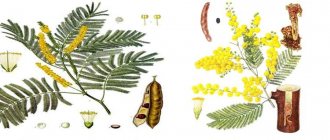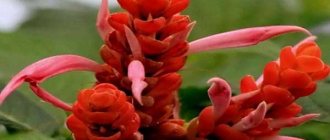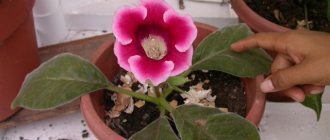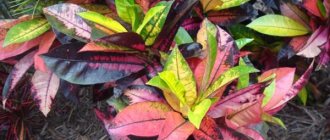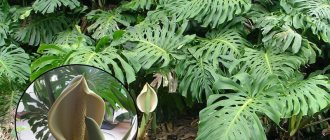From the history of appearance
The flower is native to South America. To be more precise, from the tropical rainforests of Costa Rica and Brazil. The plant belongs to the Marantaceae family. It began to be grown as an indoor plant in the last century. Initially, no more than a dozen varieties were suitable for home cultivation, but on their basis, specialist breeders created a fairly large number of hybrids. Today there is a very diverse mosaic of ctenantha species. Moreover, the brightest representatives are hybrids of the original varieties.
Ktenanta can decorate any interior
Description
Stromantha - home care and reproduction
Most varieties of ctenantha have an interesting contrasting leaf. The homeland of this plant is South America, where this evergreen deciduous shrub can be easily found in its usual habitat - the jungle.
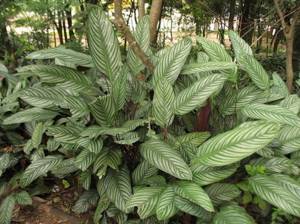
In living nature, the ctenantha is capable of growing very strongly.
It is not too difficult to organize care for a flower such as ctenanta at home. This native of the tropics is not overly whimsical. Thanks to its very compact size, the ctenanthus flower will fit perfectly into even the smallest room.
Flowering of the ctenantha when caring for it at home is a rather rare phenomenon. Even if the plant is provided with conditions as close as possible to natural conditions, it is not at all a fact that buds will ever appear. However, most flower growers are not upset by this fact at all - the flower overall looks quite inconspicuous. It is a small spikelet of red or white color.
Important! The fact that ctenanta of any type practically does not bloom in apartment conditions makes it the best option for people suffering from pollen allergies.
Popular varieties
There are a large number of varieties of tropical flowers, so it is worth taking a closer look at those varieties that are best suited for planting in an apartment on a windowsill.
Ktenanta Oppenheim
Bromeliad - home care, watering and propagation
Ktenanta Oppenheim creates a minimum of problems when cared for at home. It is often chosen by those who do not like to spend a lot of time caring for flowers. Oppenheim's ctenanta is a fairly tall species, growing in a pot up to 120 cm, in nature - up to almost 2 meters. The leaves of this variety are characterized by a lanceolate shape. They grow up to 20 or 30 cm in length. The foliage color of Oppenheim's calathea is alternating grayish-green and gray stripes.
Ktenanta Lubbersa
Ktenanta Lubbersa is another optimal variety for the windowsill. It is very easy to care for. The description of the variety is as follows: plant height - from 80 to 100 cm, leaves are oblong, dark green on top, pale green at the bottom with variegated veins.
Ctenanta Amagris
Many people know Ctenanta Amagris. This herbaceous perennial has oval oblong leaves, the length of which ranges from 15 to 25 centimeters. Their color is silver-green, very light, with thin stripes of a dark green hue along the veins. Another feature of the Amagris leaf is the burgundy tint of its lower part. Everything together looks very impressive and original.
Ctenanta pubescent
Among the ctenanta flowers of different species, the pubescent ctenanta is considered the most capricious. The plant is especially picky about air humidity, temperature and drafts. The flower looks very interesting. It has dark green, egg-shaped leaves with light green stripes. The latter look as if they were painted with paint using a brush. The pubescent variety grows up to 80 centimeters in height.
Ctenanta compressed
Another interesting variety that often finds a place on window sills is Calathea ctenanta compresses. This species grows to an average height of 90 cm. Features of Ctenantha compressa include glossy oval-shaped leaves, the length of which can reach 30 cm. They are usually located on high basal carts. The leaf blades are entire-edged and have a rich dark green hue.
Ktenanta Burle Maxi
Many people know Ktenanta Burle Maxi as the smallest plant in the family (up to 20 cm), which is characterized by very original colored leaves. The foliage itself is thick, almost rectangular in shape with wide dark stripes and a dark purple underside. In nature, Burle Maxi forms an almost continuous carpet consisting of bright leaves, the length of which is 10 cm, width - 5 cm.
Ctenanta Setosa
Ctenanta Setosa has elongated, dark green, ovoid leaves. The longitudinal stripes located on them are most often painted in a bluish or light green shade. The height of the plant can reach 80-90 centimeters. The perennial feels quite comfortable as a houseplant and does not require special conditions for successful cultivation.
Ktenanta Tricolor
The main feature of Ctenanta Tricolor is (as the name suggests) tricolor leaves. It is a hybrid of the Oppenheim variety, with striped yellow-green leaves and a bright purple underside. Externally, the flower resembles one of the Stromanth varieties.
Important! Ctenanta is a poisonous flower.
It is not recommended to grow it in houses where pets live.
Some types of ctenanta
Ctenanthe burle-Marx , or Ctenanthe burle-marxii. The homeland of the species is Brazil. An adult plant can reach 20-40 cm in height. The leaf blade is about 10 cm long and 5-6 cm wide, oblong or obovate with a short pointed tip, glabrous, light green, has beautiful dark green stripes along the lateral veins, the reverse side is purple. The flowers are collected in apical inflorescences, small, creamy white. The fruit is an elliptical pubescent capsule. Flowering occurs in February.

Ktenanta Lubbers. © Maja Dumat
Ctenanta Lubbers , or Ctenante Lubbers (Ctenathe lubbersiana). The homeland of the species is Brazil. An adult plant can reach a height of 75 cm. It has oblong green leaves with beautiful yellow or whitish-yellow feather-shaped strokes, green on the reverse side.
Ctenanthe oppenheimiana , or Ctenanthe oppenheimiana. Plant up to 90 cm tall. The leaves are on long petioles, oblong in shape, about 20-40 cm long. The surface of the leaf is velvety with light green and cream stripes, the reverse side of the leaf is purple. Tricolor form available.
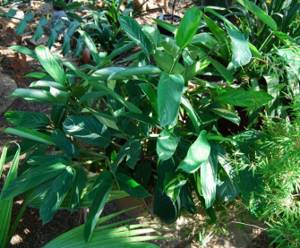
Ctenanta compressed. © Ranulf Bennet
Ctenanta compressed , or Ctenanthe compressa. Grows in tropical rain forests in Brazil. Perennial herbaceous plants. The leaves are oblong-ovate, 40 cm long and 10 cm wide, shortly pointed, rounded at the base, green, with a compressed, pubescent sheath. The flowers are collected in spikes 20-30 cm long. Deciduous ornamental plant.
We are waiting for your advice and observations on growing this bright plant!
Home care
Any indoor plant requires proper care for normal growth. In the case of the ctenanta, we are talking about the following significant points.
Temperature
Dieffenbachia - home care, reproduction
The flower is highly sensitive to any temperature changes. Drafts and hypothermia of the root system can cause disease or even death. The soil must necessarily warm up above +18°C, regardless of the season. In summer, the optimal temperature is +22 degrees.
Lighting
The lighting required is bright enough, but at the same time diffused. If the light is too bright, the leaves may begin to fade and the size of the plates will decrease. In winter, indoor shrubs in most cases will require additional lighting due to the short daylight hours. The problem can be solved using fluorescent lamps.
Watering
Planting requires moderate watering. In warm weather, the soil needs to be moistened more often than in winter. Neither overdrying nor waterlogging should be allowed under any circumstances. Well-settled, soft, warm water is best suited for the procedure. It is allowed to use water passed through a filter.
Spraying
To maintain a suitable humidity level, spraying will be required.
Important! There is one little secret on how to spray a plant in such a way that there are no spots or streaks left on the leaves. We are talking about using a fine spray.
The procedure should be carried out twice a day in the summer. It may not be a bad idea to place the pot in a tray with damp moss from time to time.
Humidity
To maintain a high level of humidity, along with spraying, it is recommended to purchase an air humidifier. With its regular use, the client will feel especially comfortable.
Priming
When planting a plant, be sure to organize drainage at the bottom of the pot. The soil itself should be slightly acidic, loose and nutritious. It is allowed to use ready-made substrates for arrowroot or azaleas.
Feeding
In spring and autumn, mineral fertilizers must be applied to the soil once every two weeks. In the cold season, it is enough to use fertilizing once every month and a half.
About caring for Ktenanta:
Temperature: The optimal temperature for Ktenanta in summer is 22-25 ºC, and in winter the temperature should not fall below 16 ºC. There should not be a strong difference in temperature between night and day. Ktenanta is a heat-loving plant, but it is not recommended to place the plant next to radiators or heaters in winter. In summer, the plant may suffer from the cold air flows of the air conditioner, so it should not be placed under air conditioners or in critical proximity to them. The plant is afraid of drafts and hypothermia of the root system. In the summer, the ctenant can be taken out onto the balcony or terrace, but it must be protected from direct sunlight, wind and precipitation.
Lighting: Ktenanta needs diffused lighting. An eastern or western window sill is suitable for it; it also develops well on a northern window, since the plant does not require lighting and is considered shade-tolerant. When kept in a room with a southern orientation, it is recommended to find a place for it on a table next to the window.
Ctenanthe oppenheimiana.
Watering: Should be regular and plentiful. It is necessary to water with warm, soft, settled water. The frequency of watering depends on the temperature of the content. In summer, watering should be carried out as soon as the top layer of soil dries out. At the same time, in summer, on hot sunny days, you need to water more often, and in cold and cloudy weather - less often. In winter, watering is reduced, but you should not let the substrate dry out completely. The water from the pan must be drained after watering. Excess water in the soil can cause root rot.
Air humidity: Ctenanta is demanding of air humidity and its daily procedure should be to spray the leaves with soft, settled water in the morning and evening, especially if the plant is kept in a room with dry air. In order to increase humidity, you can use pallets with wet expanded clay. In this case, the bottom of the pot should not touch the water. It is necessary to clean the leaves from dust and periodically give the plant a shower, but make sure that after the shower the drops do not remain on the foliage.
Fertilizers: It is necessary to fertilize in spring and summer once a month, and in winter, watering can be reduced to once every 2 months. Fertilizers must be applied in half the dose, since the plant is very sensitive to fertilizers. Next, complex fertilizers for decorative deciduous plants are used for feeding.
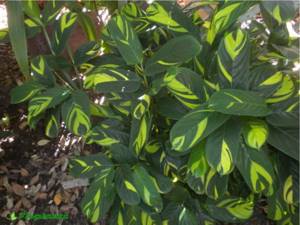
Ctenanthe lubbersiana.
Soil: Soil for decorative foliage plants, a universal substrate, is suitable for Ktenanta. You can use special soil for Marantaceae. It is advisable to add charcoal, perlite, coconut soil and humus. Good drainage at the bottom of the pot is necessary.
Transplantation: It is necessary to replant once a year in order to accelerate the development of the plant, and for adults only once every 3 years using the transshipment method. The pot should be wide and not deep and 1-2 cm larger than the previous one. When transplanting, it is recommended to wrap the roots of the plant with sphagnum moss. After transplantation, the plant is not fertilized for a month. If replanting is not carried out, it is recommended to replace the top layer by adding fresh substrate.
Pests Ktenanta. Damaged by spider mites and scale insects.
Features of reproduction
Many gardeners are interested in how ctenanthas are propagated.
Germination of seeds
It is very problematic to propagate the crop by germinating seeds, since it practically does not bloom in indoor conditions. Accordingly, the problem of finding planting material arises.
Rooting cuttings
Often the flower is propagated by apical cuttings. To do this, they are cut in the summer, carefully ensuring that each cutting has at least three leaves. The cuttings are placed in a container of water, carefully covered with plastic wrap. When young roots appear, the seedling can be moved into the ground.
Air layering
Air layering is a section of a plant that is specially stimulated to form roots by surrounding it with soil. This method is practically not used with ctenanta.
Dividing the bush
Most often, the described indoor flower is propagated by dividing the bush. As a rule, the method is used on an adult specimen. The plant is pulled out of the ground, the roots are shaken off the soil, divided into several parts, being careful not to damage the root system, and transplanted into different containers.
Reproduction of ctenanta
Ctenanta is propagated by dividing the bush and rooting apical cuttings.
They are propagated by division during transplantation (large plants are carefully divided into 2 - 3 new specimens, taking care not to damage the roots) - they are planted in a peat-based substrate, after which it must be thoroughly watered with lukewarm water and the surface allowed to dry before the next watering. The pots are placed in a loosely tied plastic bag and kept in a warm place until the plant becomes stronger and new leaves appear.
To propagate ctenanthas by apical cuttings in late spring or summer, you need to cut cuttings 7-10 cm long with 2 - 3 leaves from new shoots of the plant, the cut is made just below the place where the leaf attaches to the stem. The cut cuttings are placed in a container with water; additionally, they can be placed in a mini-greenhouse or in a transparent plastic bag. The cuttings take root in about five to six weeks. They take root well in greenhouses with elevated temperatures and humidity. The cuttings that have taken root are planted in a peat-based planting substrate.
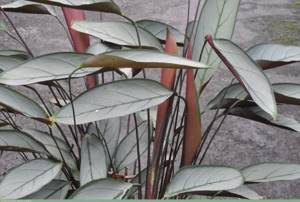
Features of transplantation
Young specimens are usually replanted annually in late spring. Older plants are quite capable of growing in one place for about 3-5 years.

The plant must be replanted very carefully
When replanting, especially close attention should be paid to the size of the pot. It is selected in direct proportion to the size of the rhizome. Under no circumstances should you choose a container that is too large. The plant will be uncomfortable in it. Excess soil can turn sour and become a breeding ground for fungus gnats. The best option would be ceramic pots in which moisture evaporates, including through the side walls.
Problems during cultivation
In the process of growing ctenants, you can encounter a number of problems. Most often we are talking about the following points.

Incorrect care leads to plant disease
Yellowing and falling leaves
In some cases, the leaves may curl, turn yellow and begin to dry out. The answer to the question of why this happens most often lies on the surface. Typically, the falling of leaves is associated with a lack of watering or with stagnation of moisture. It is enough to reconsider the organization of soil moisture and start doing everything correctly for the plant to come to life.
Leaves turning pale
The most common reason that causes leaves to turn pale is too low an air temperature. A draft can also cause a similar problem. Moving the pot with the crop to a more comfortable place will quickly return the plant to a healthy appearance.
Drying leaf tips
An incorrect watering regime can also lead to drying out of the tips of the leaves. The fact is that water for irrigation displaces air from the pores of the substrate, which leads to oxygen starvation of the crop. If you don't fill the soil, the problem will resolve itself.
Falling of lower leaves
As a rule, the falling of the lower leaves indicates the beginning of the process of rotting of the root system. The number and volume of watering should be reduced.
Pests
The greatest harm to the ctenant is caused by scale insects and spider mites. Due to the fault of the former, brown plaques appear on the surface of the stems and leaves, sucking out the cell sap. As a result, the leaves begin to dry out and fall off. Wiping the foliage with a soapy solution and spraying with a 0.15% Actellik solution will help solve the problem.
For red spider mites, infested leaves become paler, develop white spots, and begin to fall off. You can effectively combat the pest with the help of drugs Derris, Fitoverm, Fufan or Actellik.
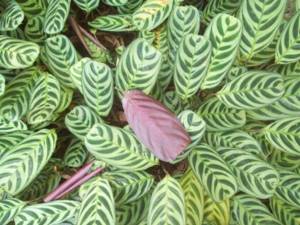
Ktenanta is a plant that requires attention and care
Diseases and pests (table)
| Disease or pest | Manifestation | Control measures | Prevention |
| Mealybug | There are lumps of white fluff on the shoots and leaves, hiding tiny insects. Leaves lose color and die. | Remove parasites manually. Spray with insecticide (actellik, actara, confidor), repeat until the pest is destroyed. | Follow proper care. A healthy plant is usually resistant to pests. Keep the leaves clean. When purchasing a new plant, inspect it; if there are signs of parasite infestation, discard it. Keep even healthy plants in quarantine for at least 2 weeks. |
| Shchitovka | Brown plaques on the bottom of the leaves, they dry out and fall off. | Remove insects with a damp cloth, treat the plant with an insecticide (Fitoverm). Repeat the treatment until you get rid of the pest. | |
| Spider mite | The leaves become discolored and dry, sometimes red-brown spots and white cobwebs appear. | The tick does not like humidity, arrange a shower (cover the soil with film). Spray the ctenant with a systemic insecticide (Fitoverm, Derris). | |
| Thrips | The leaves are dry, there are black dots below, small insects are visible. | Wash the plant to remove adult insects. Water the soil with Aktara solution three times a week to kill the larvae. | |
| Root system rotting. | The leaves are withering, but the soil is moist. | Dry the soil, adjust the watering regime. If this does not help, remove the plant from the pot, remove the rotten roots, sprinkle the cuttings with charcoal and root formers, then replant them in a new sterilized substrate. | Plant the ctenanthus in a pot of suitable size so that the soil does not become sour. Avoid overmoistening the soil and cooling the plant, especially in winter. |
| Gray rot caused by a fungus. | Darkish spots similar to mold appeared on the shoots and leaves. | Remove all affected parts. Remove the plant from the contaminated soil, treat the roots and stems with a fungicide, and replant it in new sterilized soil. |
Video: an unusual way to improve the health of ctenanta
Signs and superstitions
There are a number of superstitions associated with the flower. Moreover, they all have a predominantly positive assessment:
- If you place a ktenanta in the bedroom, family relationships will become more harmonious and gentle.
- The plant helps restore strength; people experiencing a stressful situation or suffering from prolonged depression should definitely have it.
- Placing a flower in a child's room will help the child unleash his creativity and make him more purposeful.

Ktenanta will fit perfectly into both home and office interiors
To believe or not to believe in omens is a personal matter for everyone. A flower is truly worth becoming a decoration for any room.

